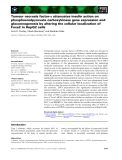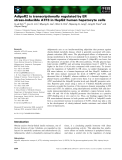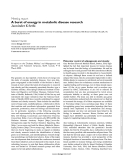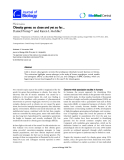
Biology of obesity
-
Obesity is a known risk factor for induction of myocardial infarction, but, paradoxically, may also confer a protective effect against subsequent remodeling leading to heart failure. In this study, we investigated the effect of leptin, the product of the obese (ob) gene, on cardiomyocyte apoptosis, a well-characterized component of cardiac remodeling after myocardial infarction.
 9p
9p  galaxyss3
galaxyss3
 07-03-2013
07-03-2013
 51
51
 2
2
 Download
Download
-
Circulating tumour necrosis factor-a(TNFa) levels, which are elevated in obesity-associated insulin resistance and diabetes, inhibit insulin signalling at several points in the signalling cascade. The liver is critical in maintaining cir-culating glucose levels and, in a preliminary investigation using the human hepatoma (HepG2) cell line in this study, we demonstrated the role of TNFa in the regulation of this phenomenon and determined the underlying molecular mechanisms.
 13p
13p  vinaphone15
vinaphone15
 25-02-2013
25-02-2013
 43
43
 2
2
 Download
Download
-
Adiponectin acts as an insulin-sensitizing adipokine that protects against obesity-linked metabolic disease, which is generally associated with endo-plasmic reticulum (ER) stress. The physiological effects of adiponectin on energy metabolism in the liver are mediated by its receptors.
 14p
14p  mobifone23
mobifone23
 21-01-2013
21-01-2013
 45
45
 3
3
 Download
Download
-
The aim of this study is to discover and characterize novel energy homeo-stasis-related molecules. We screened stock mouse embryonic stem cells established using the exchangeable gene trap method, and examined the effects of deficiency of the target gene on diet and genetic-induced obesity.
 10p
10p  mobifone23
mobifone23
 18-01-2013
18-01-2013
 27
27
 3
3
 Download
Download
-
Meeting report A burst of energy in metabolic disease research Jaswinder K Sethi Address: Department of Clinical Biochemistry, University of Cambridge, Addenbrooke’s Hospital, Hills Road, Cambridge CB2 2QR, UK. E-mail: jks30@cam.ac.uk comment Published: 27 May 2004 Genome Biology 2004, 5:327 The electronic version of this article is the complete one and can be found online at http://genomebiology.
 0p
0p  thulanh21
thulanh21
 15-11-2011
15-11-2011
 52
52
 2
2
 Download
Download
-
Tuyển tập các báo cáo nghiên cứu về sinh học được đăng trên tạp chí sinh học Journal of Biology đề tài: Obesity genes: so close and yet so far...
 4p
4p  toshiba3
toshiba3
 07-09-2011
07-09-2011
 39
39
 4
4
 Download
Download
CHỦ ĐỀ BẠN MUỐN TÌM


















